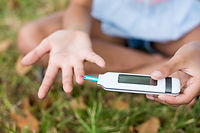
DNA Iron Sensor
The Iron Sensor analyzes whether your body absorbs too much iron from your diet and has an increased risk of developing hemochromatosis.
The Iron Sensor analyzes whether your body absorbs too much iron from your diet and has an increased risk of developing hemochromatosis.
Iron is an essential trace element for the oxygen supply of our body, playing a role in various metabolic processes and the synthesis of hemoglobin in red blood cells. Therefore, adequate intake of this trace element is essential for us.
However, an excess of iron can also be harmful to our health, leading to permanent damage to our organs. People genetically predisposed to hemochromatosis are particularly vulnerable to this condition. Hemochromatosis, also known as iron overload disease, is one of the most common inherited metabolic diseases. Mutations in certain genes cause excessive iron absorption in the small intestine, leading to iron deposition and damage to the liver, heart, pancreas, pituitary gland, and joints. Symptoms may include joint pain, severe fatigue, skin discoloration, premature graying, and hair loss, as well as diabetes, heart failure, cardiac arrhythmias, liver tumors, and cirrhosis.
The inherited form of hemochromatosis is very common in the northern European population. One in ten people carry a mutated gene variant and are thus carriers (heterozygous), while approximately one in 200 people with two mutated gene variants (homozygous) are at high risk of developing the disease. Whether the disease occurs also depends in part on other factors such as regular blood loss or nutrition.
Unfortunately, elevated liver values in laboratory findings and some symptoms that indicate iron overload disease are misdiagnosed in about 70% of cases, leading to incorrect treatment and worsening of symptoms. A genetic test can provide an early diagnosis and simple guidelines for prevention to reduce iron levels in the blood.
With our Iron Sensor, our laboratory examines the saliva sample for three genetic variations related to iron uptake from food. This allows us to determine whether too much iron is absorbed from food and whether genetic predispositions for iron overload disease have been inherited.
We evaluate the analysis results in a written report that shows the risk of developing hemochromatosis and presents individual preventive measures to prevent iron overload disease.
In this context, our Iron Sensor can be valuable for health prevention and help prevent excess iron and serious organ damage.
Overview of DNA Iron Sensor
DNA Analysis of 3 genetic variations relevant to iron uptake
Assessment of the risk of developing hemochromatosis
Reliable & ISO-certified analysis conducted by our laboratory
A written report on the test results
Individual recommendations for moderate iron intake





